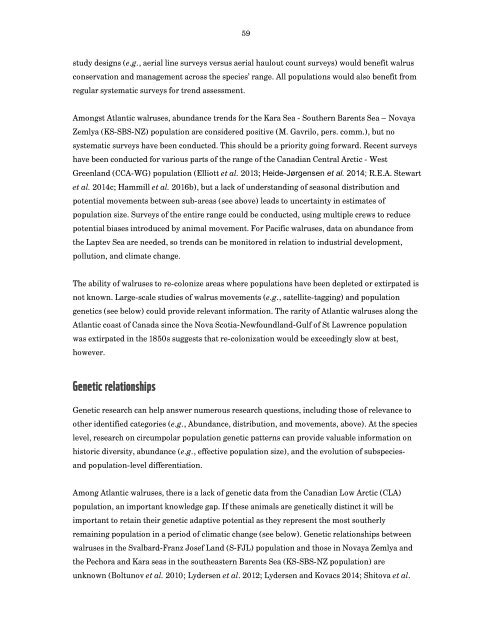The State of Circumpolar Walrus Populations
walrusreport
walrusreport
Create successful ePaper yourself
Turn your PDF publications into a flip-book with our unique Google optimized e-Paper software.
59<br />
study designs (e.g., aerial line surveys versus aerial haulout count surveys) would benefit walrus<br />
conservation and management across the species’ range. All populations would also benefit from<br />
regular systematic surveys for trend assessment.<br />
Amongst Atlantic walruses, abundance trends for the Kara Sea - Southern Barents Sea – Novaya<br />
Zemlya (KS-SBS-NZ) population are considered positive (M. Gavrilo, pers. comm.), but no<br />
systematic surveys have been conducted. This should be a priority going forward. Recent surveys<br />
have been conducted for various parts <strong>of</strong> the range <strong>of</strong> the Canadian Central Arctic - West<br />
Greenland (CCA-WG) population (Elliott et al. 2013; Heide-Jørgensen et al. 2014; R.E.A. Stewart<br />
et al. 2014c; Hammill et al. 2016b), but a lack <strong>of</strong> understanding <strong>of</strong> seasonal distribution and<br />
potential movements between sub-areas (see above) leads to uncertainty in estimates <strong>of</strong><br />
population size. Surveys <strong>of</strong> the entire range could be conducted, using multiple crews to reduce<br />
potential biases introduced by animal movement. For Pacific walruses, data on abundance from<br />
the Laptev Sea are needed, so trends can be monitored in relation to industrial development,<br />
pollution, and climate change.<br />
<strong>The</strong> ability <strong>of</strong> walruses to re-colonize areas where populations have been depleted or extirpated is<br />
not known. Large-scale studies <strong>of</strong> walrus movements (e.g., satellite-tagging) and population<br />
genetics (see below) could provide relevant information. <strong>The</strong> rarity <strong>of</strong> Atlantic walruses along the<br />
Atlantic coast <strong>of</strong> Canada since the Nova Scotia-Newfoundland-Gulf <strong>of</strong> St Lawrence population<br />
was extirpated in the 1850s suggests that re-colonization would be exceedingly slow at best,<br />
however.<br />
Genetic relationships<br />
Genetic research can help answer numerous research questions, including those <strong>of</strong> relevance to<br />
other identified categories (e.g., Abundance, distribution, and movements, above). At the species<br />
level, research on circumpolar population genetic patterns can provide valuable information on<br />
historic diversity, abundance (e.g., effective population size), and the evolution <strong>of</strong> subspeciesand<br />
population-level differentiation.<br />
Among Atlantic walruses, there is a lack <strong>of</strong> genetic data from the Canadian Low Arctic (CLA)<br />
population, an important knowledge gap. If these animals are genetically distinct it will be<br />
important to retain their genetic adaptive potential as they represent the most southerly<br />
remaining population in a period <strong>of</strong> climatic change (see below). Genetic relationships between<br />
walruses in the Svalbard-Franz Josef Land (S-FJL) population and those in Novaya Zemlya and<br />
the Pechora and Kara seas in the southeastern Barents Sea (KS-SBS-NZ population) are<br />
unknown (Boltunov et al. 2010; Lydersen et al. 2012; Lydersen and Kovacs 2014; Shitova et al.


